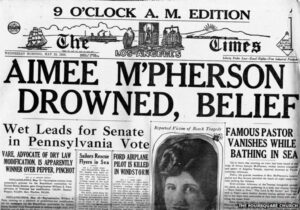by James Scott Bell
@jamesscottbell
 Was she a prophet, a huckster, a healer, or a performer? Or a combination of them all?
Was she a prophet, a huckster, a healer, or a performer? Or a combination of them all?
Aimee Semple McPherson, known to her followers as Sister Aimee, was born in 1890 on a farm in Canada. As a teen, she fell under the spell of a Pentecostal preacher named Robert Semple, whom she later married. When Semple died on a missionary trip, Aimee carried on the ministry herself.
Those who heard her called her “spellbinding.”
 In 1923 she made Los Angeles her home base, building a tabernacle in Echo Park. The Angelus Temple is still there, headquarters for the denomination she founded—The Foursquare Church.
In 1923 she made Los Angeles her home base, building a tabernacle in Echo Park. The Angelus Temple is still there, headquarters for the denomination she founded—The Foursquare Church.
Along the way she married a man named McPherson, who apparently couldn’t take the secondary role he played to the hugely popular Sister Aimee. They divorced in 1921.
But that didn’t slow down Aimee, whose sermons were often like theatrical spectacles. She would stage elaborate productions, often with her in costume and sets like a Broadway show.
The crowds were overflowing.
Then, in 1926, after going for a swim at Venice Beach, Sister Aimee disappeared.
The newspapers feared drowning. A massive search proved fruitless.
 Several weeks went by. Her stunned followers began to pray for her resurrection.
Several weeks went by. Her stunned followers began to pray for her resurrection.
Which happened, in a way.
In the dusty little Mexican town of Agua Prieta, a family was dining when there was a knock on the door. They opened it up to a tired-looking woman who told them she had escaped kidnappers, and could they help her?
It was Aimee Semple McPherson.
Newspapers across the country trumpeted the news. The D.A. wanted to know the details.
Sister Aimee told the authorities that on that day at Venice Beach, three strangers had asked her to pray for a sick child in the back of their car. When she got to the car (she said) they pushed in her and chloroformed her. They took her to an “adobe shack” in Mexico and held her there for ransom. The authorities wanted to know why no one ever received a ransom demand. Sister Aimee said she couldn’t speak for the kidnappers.
Something else the authorities noticed. Around the same time Sister Aimee went missing, so did the sound engineer for the Angelus Temple, Kenneth Ormiston.
Tongues began to wag. Had she and Ormisten run off together? Was the kidnapping story a way to cover up a tryst?
To this day, it’s an open question. The newspapers, as they are wont to do, seized on the potential of scandal. Eventually the District Attorney went to the grand jury to get an indictment against Aimee and her mother, Minnie, for perpetuating a gigantic hoax.
Imagine that.
Sister Aimee’s famous tenacity took hold. When reporters kept after her, she would calmly reply, “That’s my story and I’m sticking to it.”
She and her mother we’re bound over for trial, on the charge of “criminal conspiracy to commit acts injurious to public morals and to prevent and obstruct justice.” But the D.A.’s key witness, who had claimed she was hired to help perpetuate the hoax, suddenly changed her story. Why? One theory is that an admirer of Sister Aimee, William Randolph Hearst no less, offered a little financial incentive to the witness.
In any event, without that testimony the case had to be dismissed.
The D.A., Asa Keyes, told the press, “Let her be judged in the court of public opinion.”
That court wasn’t kind at first. But in L.A., time is on the side of charming dissemblers. Sister Aimee immediately went on what she called her “vindication tour.” She came back to L.A. not just a local celebrity, but world famous. She even received an invitation from Mahatma Gandhi to visit him. Which she did.
She continued to preach until 1944, when she was found dead in an Oakland hotel room. The cause of death was officially ruled an accidental overdose of barbiturates.
Or was it suicide?
Either way, Aimee Semple McPherson passed through the portals of death into a permanent place in the annals of scandalous celebrity immortality.
That’s how it happens in my town.
Did your hometown have a local, controversial character? Ever used him or her in a book?
If you’d like to hear Sister Aimee at the height of her popularity, go here.
Some of the material in this post I owe to Daniel Mark Epstein’s biography, Sister Aimee: The Life of Aimee Semple McPherson.

“Did your hometown have a local, controversial character?”
Oh, yes. Charlotte was the home of Jim and Tammy Bakker. They were the Sister Aimees of the 80s.
Fun fact: My wife Julie had a speaking role in the biopic The Eyes of Tammy Faye.
Ah, yes, I well remember.
Congrats to your wife.
I live outside Butte, Montana. We have the Copper Kings. I haven’t used any of them in a story yet.
This is from Wikipedia:
The Copper Kings were the three industrialists Marcus Daly, William A. Clark, and F. Augustus Heinze. They were known for the epic battles fought in Butte, Montana, and the surrounding region, during the Gilded Age, over control of the local copper mining industry, the fight that had ramifications for not only Montana, but the United States as a whole.
The battles between Clark, Daly, and Heinze, and later between just Heinze and industrialist financiers William Rockefeller and Henry H. Rogers are a large chapter in Montana history. Eventually, Daly’s original company, known as Anaconda Copper emerged as a monopoly, expanding into the fourth largest company in the world by the late 1920s.
Clark had a daughter that had controversy around her:
Huguette Clark died at Beth Israel Medical Center on May 24, 2011, two weeks before she would have turned 105. She spent a total of 20 years living in a hospital room before a final move to intensive care a month before her death. She left behind a fortune of more than $300 million.
The Gilded Age is fascinating. Thanks for this.
20 years in a hospital room! That reminds me to get that medical form signed & notarized! Yeesh. No thanks!
Back in the 1940s and early 1950s Memphis had Georgia Tann who stole babies from hospitals and sold them on the black market. There have been several books about her, and I used that crime in one of my Natchez Trace books–Deception.
Oh, yes. I recently read about her. Horrific.
In my hometown of Sacramento, elderly widow Dorothea Puente ran a boarding house. She killed her elderly boarders, buried them in her backyard, and cashed their social security checks.
I have not used her in a book, but it does make for some good fodder.
Sounds eerily like Arsenic and Old Lace.
Interesting story, Jim
I try to stay away from discussing the “scandalous celebrity immortality” because of the falsehoods that so often are attached.
Years ago, I suffered a hand injury from a table saw accident. Within one hour of being in the emergency room, the rumor had spread through our small town that I had cut off my arm with a chain saw. At least it wasn’t my head.
I’m glad, too, Steve!
You’re right, Steve. It is so often hard to tell truth from falsehood, even more so these days. And now everybody truly does seem to have Andy Warhol’s 15 minutes of fame.
Fascinating! (Deb channels Mr. Spock…) Thanks for this peek into a very colorful character, Jim.
I don’t know of any “famous” folks in little old Yakima County, but we certainly have lots of ne’er-do-wells. It’d be hard to choose.
Happy Sunday! 🙂
A town drunk or eccentric, perhaps.
There is one interesting crime-related investigation which is on-going in Yakima County, as in other jurisdictions also. In Yakima it’s a big deal. I haven’t followed it closely, though. Stories crop up frequently in the media.
We’ve had many cases of missing indigenous women, some of whose bodies have been found, others are still missing.
I’ve never heard whether or not a serial killer is suspected, but the idea has been floated.
I have Bruce Jenner from my town (or whatever her name is now), and a guy who shot up an elementary school on december 14, 2012. Neither will ever be in a book of mine.
I ran into Bruce, when he was Bruce, at a Starbucks, and talked with him about my childhood dream to be a Decathlete. He was nice about it.
In the early 2000s, a wealthy local philanthropist/contractor/respected town father was arrested for sex with underage girls among other sex-related crimes. He targeted girls and young women in bad financial straits, “counseled” them, provided them with drugs and money, then pushed them into prostitution. Over a period of five years, investigators found he had spent millions for sex.
He was convicted on four counts and sentenced to 20 years. He served two, was released on probation, and moved to Arizona. He was sued by several of his victims and his former defense attorney, which forced him into involuntary bankruptcy but reportedly millions had already “disappeared.”
From time to time, he petitions to be released from probation. So far, no dice.
Yeesh. Doesn’t sound like justice served, does it?
D.B. Cooper is the first person to spring to mind in answer to your question. Boarding Northwest Airlines Flight 305 for Seattle on November 24, 1971, and, once seated, with the airplane in flight, showing a brief case with an alleged explosive device inside to a flight attendant and then a note demanding four parachutes and $200,000 in cash. After the plane landed in Seattle, the passengers disembarked, the money and parachutes delivered and he and the crew took off for Mexico City. “Cooper” bailed out of the plane somewhere between Seattle and Reno. He was never seen again.
Growing up near Portland this became almost a legend. The FBI interviewed a huge number of people, with a list of suspects, and had one individual they thought pulled it off. Then there was the bundle of mouldering package of bills found by a boy with serial numbers matching some of the ransom money, seemingly proving that the hijacker had perished in his night-time drop, a very dangerous undertaking.
We still don’t know for sure what happened to “Dan Cooper.”
Forgot about Mr. Cooper! It was big news around here, too.
Cooper is one of the great unsolveds of all time, up there with Amelia Earhart and Judge Crater.
Judge Crater? Do tell…!
https://www.history.com/this-day-in-history/joseph-force-crater-becomes-the-missingest-man-in-new-york
Thanks, Jim! Very interesting . . . I suppose there might be lots of skeletons under buildings in many cities…
Savannah is known for some of the pirates, including Blackbeard, who apparently used it as a home base in the eighteenth century. (That was a bit before my time.)
The Pirate’s House Restaurant in Savannah was established way back then, and I believe is still in business.
I don’t know much about the pirates, but I’m sure they were a colorful bunch. Makes me want to do some research and write a book. 🙂
Let me recommend Blackbeard the Pirate starring Robert Newton, and Morgan the Pirate starring Steve Reeves.
Whelp, I’ve got no skeletons in my home town. But I truly enjoyed your telling of Aimee’s saga.
Not even some scattered bones? Wow…
As another Angelino, we share the same characters. OJ, Manson, to name a couple more. I remember my parents mentioning Aimee. My mom was more interested in the entertainment celebrities, though. I went to school with the offspring of quite a few of them, so she always looked forward to Back to School nights.
Leave us not forget Robert Blake.
I suppose there are or were local notables around here but the only entertaining one one I can think of right now is Tiny Tim, he of the stringy hair and the ukulele. Lived downtown in a hotel room.
Donald Piper was another, a serial killer who was quite the ladies’ man. One time when a guy from Accurate Mechanical was working on the HVAC in the Madison County courtroom area I chatted with him and he had worked with Piper and was astounded at the number of girlfriends Piper had. He was convicted ot two murders.
The courtroom itself was interesting and had many strange stories stories to tell. It had a hanging ceiling but above the hanging ceiling was a whole other section with second level gallery seats and hanging chandeliers. It is now accessible only by a stairwell. I was challenged by the janitor to climb to the top of the clock tower one time-never again.
In the basement are the old jail cells and on one night in 1883 a man named John Hamner who had robbed and murdered for his pension money and old veteran known as Uncle Billy, was hauled out of his cell and after an impromptu trial was hung from a tree in the southwest corner of the town square.
That story is the bases of a WIP I am cooking up.
There are those who say Tin Tim murdered many a song. But I think those others would make for better fiction.
Fun blog, Jim. South Florida has a long list of scalawags, living and dead. I like to hang around an Italian restaurant where retired Mafia dons go and eavesdrop on their conversations. They mostly talk about their cholesterol.
Do they have a Jimmy Hoffa Special?